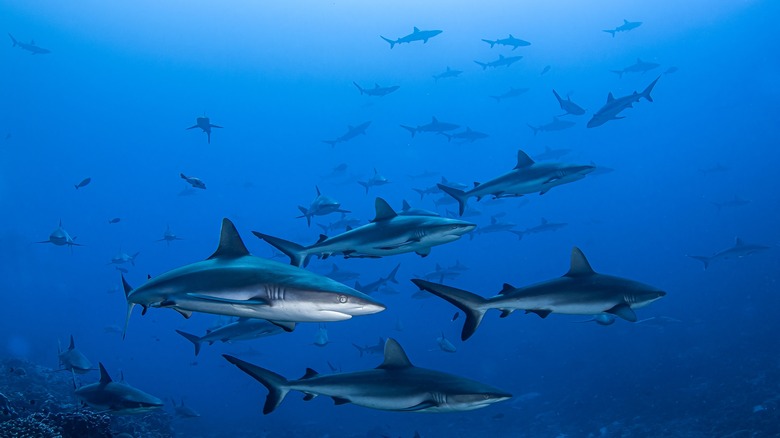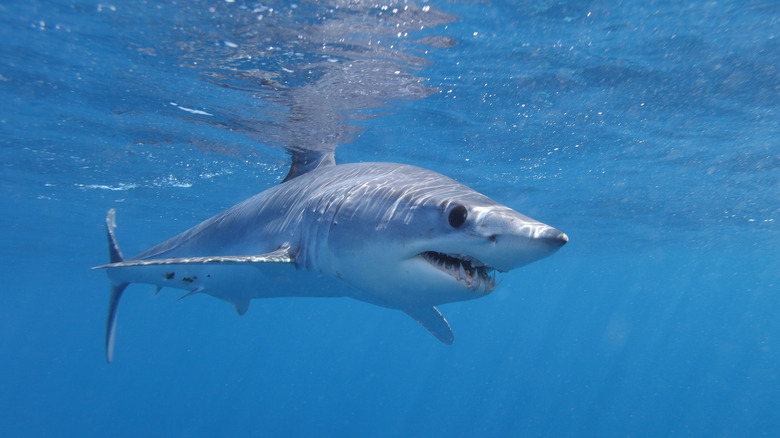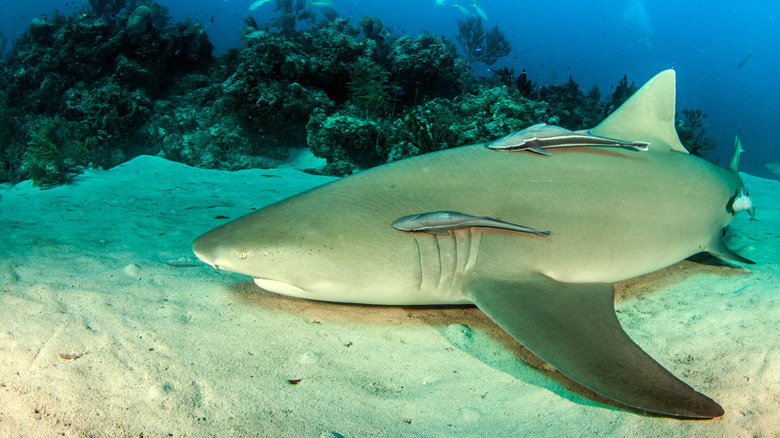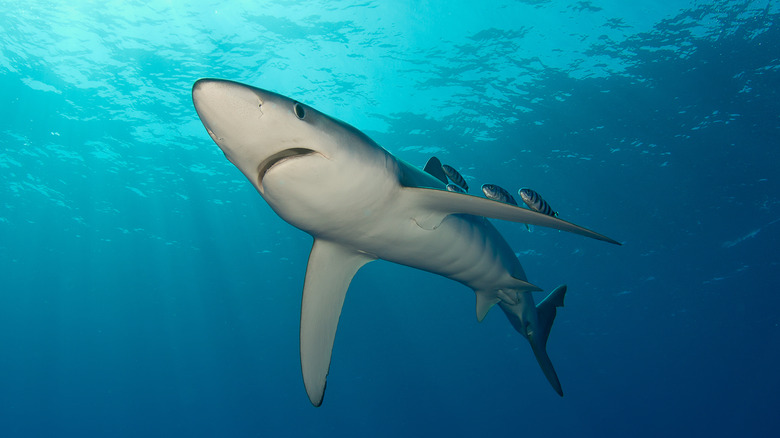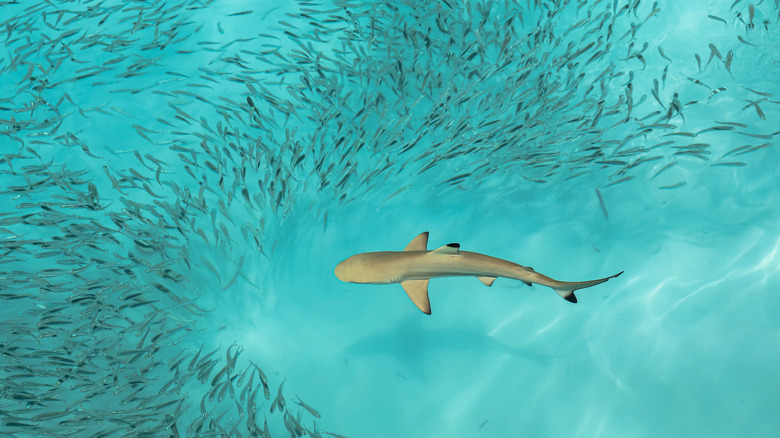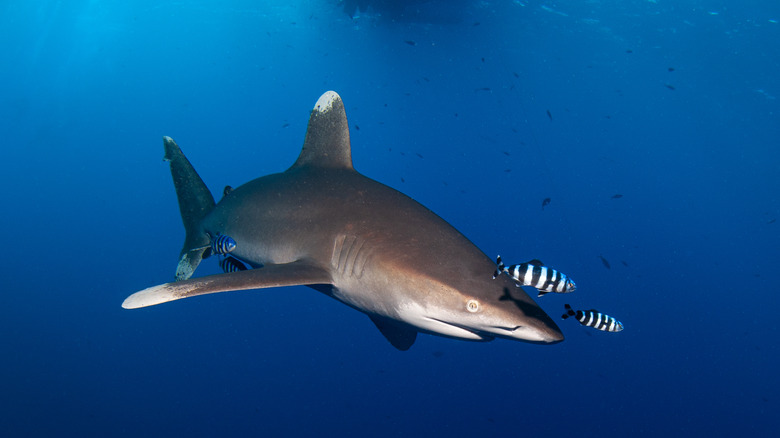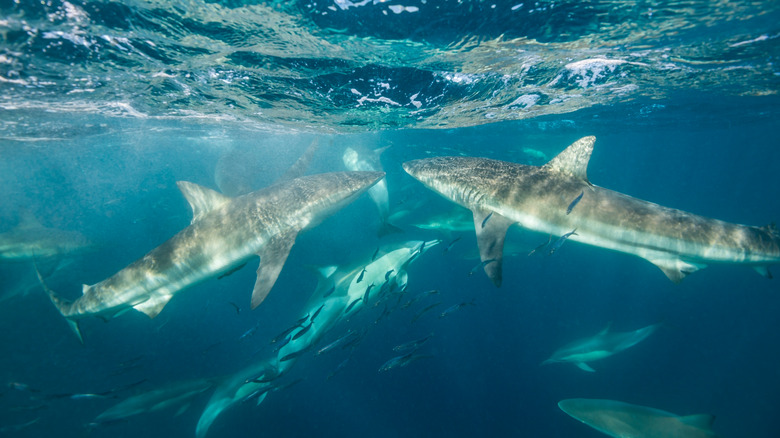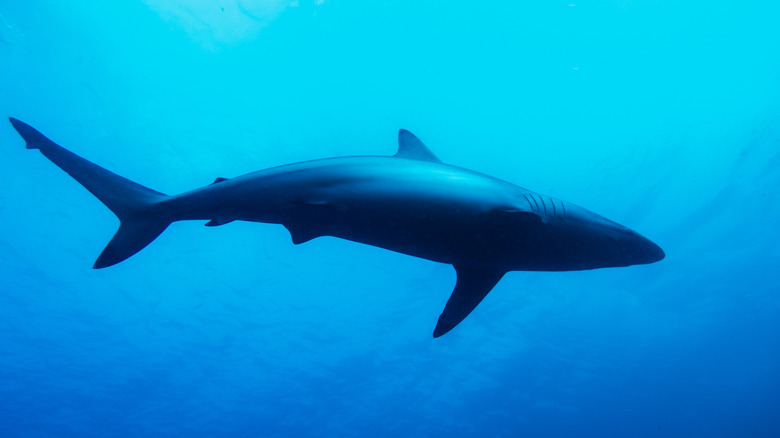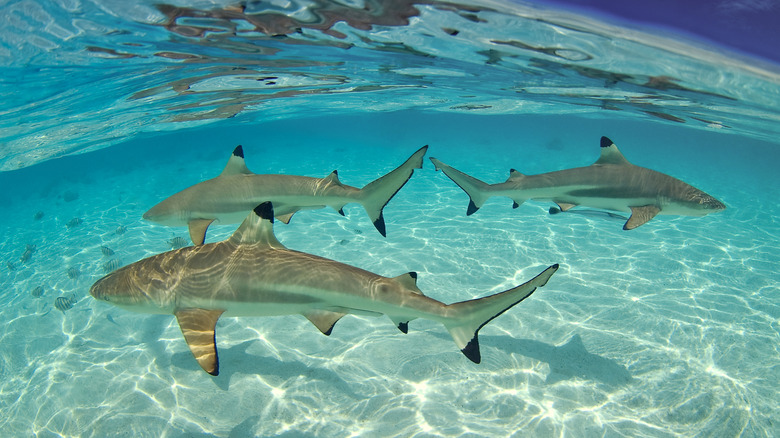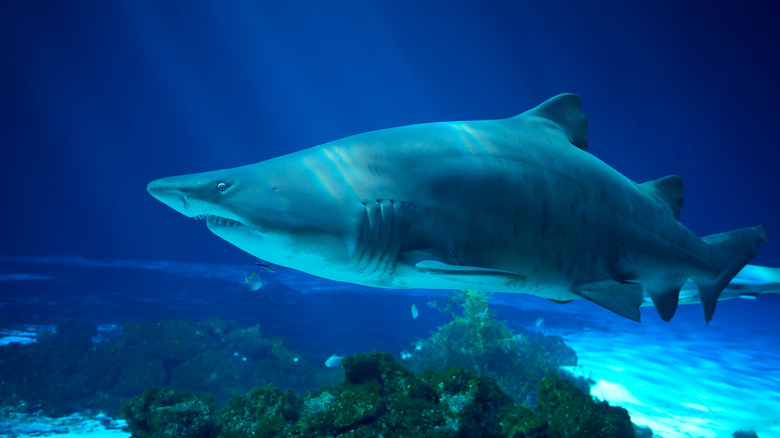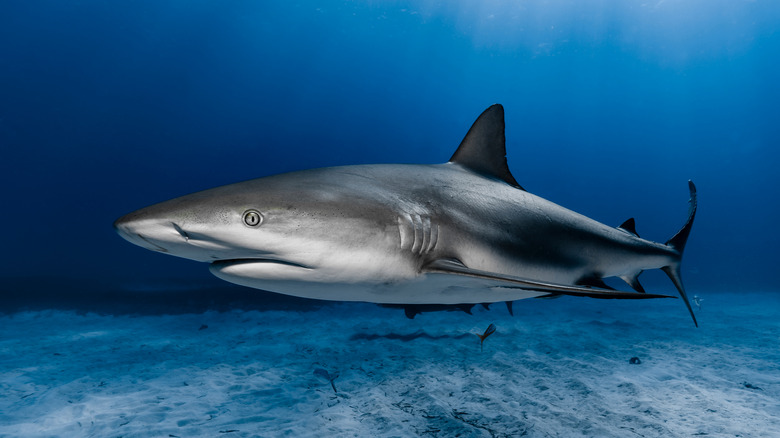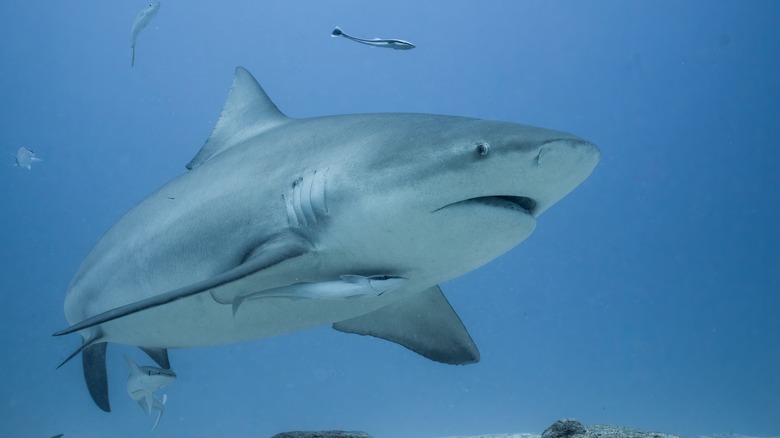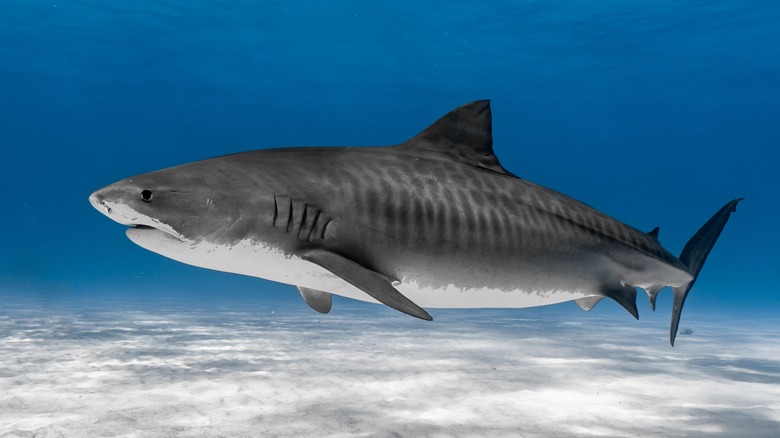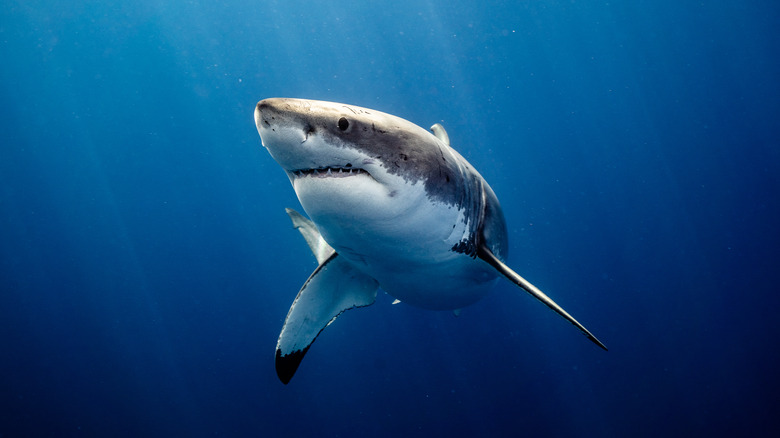15 Types Of Sharks, Ranked By Danger Level
Few creatures command as much awe and fascination in the vast blue expanse of our oceans as sharks. These magnificent predators, with their sleek bodies and razor-sharp teeth, evoke both fear and admiration. From the graceful movements of these gentle giants to the stealthy ambushes of the more aggressive species, sharks inhabit a realm that captures the imagination of swimmers, divers, surfers, and tourists alike.
While many encounters with sharks end peacefully, there's no denying that some species have earned a reputation for aggression and, in rare cases, attacks on humans. Factors such as mistaken identity, curiosity, territorial defense, and hunger can contribute to these incidents. Moreover, Phys.org reports that as human populations grow and coastal activities increase, encounters between sharks and people become more frequent. This trend has led to a rise in reported attacks in recent years.
The Florida Museum has meticulously documented every unprovoked shark attack from around the world since 1580. Their data is invaluable to researchers who study patterns and trends that shed light on the relative danger posed by different shark species. It's important to note that categorizing the threat level of sharks based on unprovoked attacks rather than all attacks offers a more nuanced perspective than labeling them as indiscriminate killers. Just as a protective mother bear would defend her cubs, sharks may react aggressively when they perceive a threat to themselves or their territory. With this understanding, let's explore the 15 most dangerous types of sharks, from least to most perilous.
15. Shortfin Mako
With its streamlined body, pointed snout, and crescent-shaped tail, the Shortfin Mako (Isurus oxyrinchus) epitomizes efficiency in underwater locomotion. Its metallic blue-gray dorsal surface seamlessly blends with the ocean depths, while its white underbelly provides camouflage from below. Renowned as the fastest shark species (via Global Shark Attack File), the Shortfin Mako possesses unparalleled agility and burst swimming speed, making it a formidable hunter in the open ocean. Equipped with powerful jaws lined with rows of razor-sharp teeth, this apex predator preys upon a variety of swift marine species, including squid, fish, and even smaller sharks.
The Shortfin Mako shark typically displays elusive and cautious behavior toward people. Encounters with humans are rare, as these sharks generally avoid populated areas and do not view humans as natural prey. While they may exhibit curiosity towards divers and boats, aggressive behavior towards humans is infrequent. Statistically, the Shortfin Mako shark has been implicated in only a handful of unprovoked attacks against humans. According to The Florida Museum, there have been approximately ten confirmed cases of unprovoked encounters with Shortfin Makos, with only one resulting in a fatal outcome. These incidents are exceedingly rare, considering the vast expanse of ocean inhabited by these sharks and the frequency of human interactions with marine environments.
Overall, while the Shortfin Mako possesses formidable physical attributes and predatory instincts, its threat level to humans remains relatively low. Encounters with these sharks are more likely to be fleeting and non-threatening, highlighting the importance of respecting their domain.
14. Lemon shark
The lemon shark (Negaprion brevirostris) is a captivating species known for its distinctive yellow-brown hue, which lends it its name. These sharks typically exhibit a robust and cylindrical body adorned with a broad, blunt snout and small eyes. Their coloration serves as effective camouflage against the sandy seabed of their preferred habitats, ranging from shallow coastal waters to the edges of coral reefs.
Renowned for their social nature, lemon sharks often congregate in groups, forming loose aggregations known as "schools" or "shivers," according to Ocean Conservancy. Their gregarious behavior extends beyond mere proximity as they engage in complex social interactions and hierarchies within their communities. This social structure facilitates cooperative hunting and provides protection against potential predators.
Lemon sharks are primarily nocturnal hunters, employing stealth and ambush tactics to capture prey under the cover of darkness. Their diet consists mainly of bony fish, crustaceans, and occasionally small sharks or rays (via the National Marine Sanctuary Foundation). Despite their formidable appearance, lemon sharks are considered relatively benign. While encounters may occur in coastal waters, these sharks typically demonstrate a docile demeanor. In fact, they are more inclined to flee than confront when encountered. Documented cases of unprovoked attacks involving lemon sharks are infrequent, with only approximately 10 confirmed incidents recorded (via Florida Museum). Importantly, none of these encounters have resulted in fatalities, underscoring the low threat level posed by these sharks to human safety.
13. Blue shark
The blue shark (Prionace glauca) cuts a striking figure in the vast expanses of the open ocean with its sleek, elongated body and distinctive cobalt-blue hue. Blue sharks are highly migratory, inhabiting both deep and coastal waters across temperate and tropical regions worldwide. Their vast range encompasses a variety of marine ecosystems, from deep-sea trenches to continental shelves. As such, blue sharks are nomadic hunters, roaming the open ocean in search of prey. Their diet consists primarily of small fish, squid, and other cephalopods, which they capture with speed and precision.
Despite their formidable appearance, blue sharks are generally considered docile towards humans when encountering divers or vessels. While they may approach to investigate, aggressive behavior towards humans is rare. However, records indicate that blue sharks have been involved in approximately 13 unprovoked attacks against humans, with four of these incidents resulting in fatalities (via Florida Museum).
These incidents serve as a reminder of the potential risks associated with encounters with blue sharks. To minimize the likelihood of an attack, it's essential for individuals engaging in water-based activities in regions frequented by blue sharks to exercise caution and follow recommended safety guidelines. This includes avoiding swimming alone or in areas known to be frequented by sharks and maintaining a respectful distance if encountering them in the wild. By understanding and respecting the behavior of blue sharks, humans can coexist peacefully with these magnificent creatures while minimizing potential risks.
12. Blacktip Reef shark
Known for its sleek physique and distinctive black markings on its fins, the blacktip reef shark (Carcharhinus melanopterus) is a captivating and relatively small species of shark. With a slender body and pointed snout, this shark species epitomizes agility and grace in its underwater domain.
The blacktip reef shark is frequently seen patrolling coral reef environments in search of prey. These sharks are opportunistic feeders, preying on a variety of small fish, crustaceans, and cephalopods. Their hunting strategy often involves swift bursts of speed and intricate maneuvers, making them efficient predators within the complex ecosystems of coral reefs. Their preference for these vibrant and biodiverse environments provides them with ample food sources and shelter while also attracting recreational divers and snorkelers seeking to explore the wonders of the underwater world.
Despite their occasional proximity to popular tourist destinations, blacktip reef sharks have been involved in relatively few unprovoked attacks against humans. While they may display curiosity towards divers or snorkelers, they typically maintain a safe distance and avoid direct contact. The Florida Museum reports approximately 14 confirmed incidents of such encounters, with none resulting in fatalities. This underscores the minimal threat level posed by Blacktip Reef sharks to human safety, allowing for peaceful coexistence in their shared marine environment.
11. Oceanic Whitetip shark
The oceanic whitetip shark (Carcharhinus longimanus) is a formidable predator inhabiting the vast expanses of the open ocean, recognized by its distinctive white-tipped dorsal and pectoral fins. Their large bodies and stocky build make deep offshore environments their preferred swimming grounds.
Behaviorally, the oceanic whitetip shark is an opportunistic hunter, patrolling the open seas in search of prey. Known for its tenacity and boldness, this species often exhibits aggressive feeding behavior, capable of overpowering larger prey through sheer force and persistence. Even to humans, oceanic whitetip sharks can be potentially hazardous. Their bold and assertive nature can escalate encounters into potentially dangerous situations, especially when they are hunting for food. Documented records indicate that oceanic whitetip sharks have been involved in approximately 15 unprovoked attacks against humans, with three of these incidents resulting in fatalities, per the Florida Museum.
Attacks by oceanic whitetip sharks often occur in remote or offshore locations, where human populations are sparse and help may be limited. To minimize the risk of encountering these sharks, individuals engaging in offshore activities such as deep-sea diving or long-distance swimming should avoid swimming alone or in areas known to be frequented by oceanic whitetip sharks, staying vigilant for signs of shark activity such as fin sightings or aggressive behavior. By remaining vigilant and respecting the natural behavior of oceanic whitetip sharks, humans can mitigate the risk of encountering these predators while enjoying the wonders of the open ocean.
10. Bronze Whaler shark
The bronze whaler shark or the copper shark (Carcharhinus brachyurus) is a formidable species inhabiting coastal and offshore waters around the world, characterized by its bronze-colored body and stout build. The Victorian Fisheries Authority states that it is a highly active and opportunistic predator known for its voracious appetite and hunting prowess. Its diet consists primarily of salmon and squid, which it captures using a combination of speed, stealth, and powerful jaws lined with sharp, serrated teeth.
Bronze whaler sharks prefer subtropical coastal waters, where they can be found patrolling rocky reefs, coastal shelves, and offshore islands. They are also known to inhabit deeper waters further offshore, particularly during migrations or seasonal changes in prey availability (via Marine Bio).
Bronze whaler sharks are generally considered to be relatively low-risk. However, bronze whaler sharks have been reported to have been involved in approximately 16 unprovoked attacks against humans, with one of these incidents resulting in a fatality, per Florida Museum. Attacks by bronze whaler sharks most commonly occur in coastal areas where humans engage in water-based activities, especially surfing and fishing. To reduce the risk of running into these sharks, individuals should refrain from swimming near fishing grounds where these sharks may be hunting. By staying alert and acknowledging the inherent behaviors of bronze whaler sharks, individuals can diminish the chances of encountering conflicts while relishing the coastal waters they inhabit.
9. Spinner shark
Named for its acrobatic aerial displays, the spinner shark (Carcharhinus brevipinna) is renowned for its spinning leaps out of the water, particularly when hunting or evading predators. Spinner sharks are highly active hunters, often observed patrolling shallow coastal waters in search of prey. Their diet primarily consists of small bony fish, squid, and crustaceans, which they capture using their sharp, serrated teeth and impressive agility. Spinner sharks are known for their distinctive hunting technique of rapidly spinning through schools of fish, using their long tail to stun and incapacitate their prey.
Spinner sharks are generally considered to be low-risk to humans. While California State University reports some instances of these apex predators biting swimmers, aggressive behavior toward humans is rare. In fact, of the 16 unprovoked attacks against humans documented by the Florida Museum, none have been fatal.
In light of the attacks by spinner sharks in shallow coastal waters, where human activities like swimming, surfing, or fishing are common, it's imperative for individuals to take proactive measures and adhere to safety protocols. Avoiding solitary swims or known spinner shark habitats. By maintaining vigilance and acknowledging the innate behaviors of spinner sharks, people can partake in coastal activities securely, thus mitigating the potential for conflicts.
8. Hammerhead shark
The Hammerhead shark, known for its distinctive T-shaped head, belongs to the Sphyrnidae family and encompasses several species with varying sizes and behaviors. Its unique head shape, called a cephalofoil, is characterized by horizontal extensions, giving it an unmistakable appearance. Hammerhead sharks are renowned for their remarkable sensory capabilities and efficient hunting strategies. Their wide-set eyes provide panoramic vision, allowing them to detect prey with exceptional efficiency, while the electroreceptors located in their cephalofoil enable them to sense weak electrical signals emitted by potential prey hiding in sand. Hammerhead sharks are primarily carnivorous, feeding on a diverse array of marine organisms such as fish, squid, and crustaceans.
Hammerhead sharks inhabit a wide range of oceanic environments, including coastal areas, continental shelves, and offshore waters. They are commonly found in tropical and temperate regions worldwide, where they can be observed patrolling coral reefs, seagrass beds, and rocky habitats in search of food. These sharks are also known to undertake long-distance migrations following seasonal shifts in prey abundance or water temperature.
In terms of disposition towards humans, hammerhead sharks are generally considered to be low-risk. Hammerhead sharks have been involved in approximately 18 unprovoked attacks against humans, but none of these incidents have been fatal, according to the Florida Museum. Refraining from swimming alone or wearing shiny jewelry or brightly-colored clothing (via Discover Wildlife) are essential precautions to follow in order to enjoy coastal waters safely and minimize the likelihood of conflicts.
7. Wobbegong shark
The wobbegong shark, belonging to the family Orectolobidae, is a fascinating and uniquely adapted species found primarily in the shallow coastal waters of the Indo-Pacific region. Its name, derived from an Aboriginal Australian term meaning "shaggy beard," aptly describes the distinctive fringed flaps around its mouth and chin. Wobbegong sharks typically have flattened bodies and intricate patterns that provide excellent camouflage against the seafloor, making them expert ambush predators (via Abyss).
Behaviorally, wobbegong sharks are nocturnal hunters. They spend much of their time resting on the ocean floor during the day and actively foraging for prey at night. They primarily feed on bottom-dwelling fish, crustaceans, and cephalopods, using their powerful jaws and sharp teeth to ambush unsuspecting prey. Wobbegong sharks are generally docile and sluggish, preferring to rely on camouflage rather than aggression to evade potential threats.
Despite almost double the number of unprovoked attacks against humans, in comparison to the hammerhead shark, wobbegongs are considered to be low-risk. After all, 31 attacks worldwide since 1580 are still more than extremely rare. While they may become defensive if provoked or accidentally stepped on, they are not known to actively seek out human prey. Plus, no incidents involving wobbegongs have been fatal, per the Florida Museum.
6. Blacktip shark
Distinct from the blacktip reef shark, the blacktip shark (Carcharhinus limbatus) is a sleek and agile predator found in coastal and offshore waters around the world. It also derives its name from the distinctive black markings on the tips of its fins, particularly the dorsal fin, which contrasts sharply against its grayish-blue body. With a streamlined form and pointed snout, the Blacktip shark exhibits remarkable swimming prowess and maneuverability in its marine environment.
Blacktip sharks are active hunters, often observed patrolling shallow coastal waters in search of prey. Their diet primarily consists of small fish, including mullet, sardines, and herrings, as well as crustaceans and cephalopods. These sharks are often encountered in areas where their preferred prey species congregate, such as near river mouths or inshore feeding grounds.
While they can become aggressive, blacktip sharks are generally still not perceived as threatening to humans. However, according to American Oceans, they have been known to bite humans unprovoked more often than other types of sharks. The Florida Museum reports that blacktip sharks have been involved in approximately 35 unprovoked attacks against humans, but none of these incidents have been fatal.
5. Sand Tiger shark
The sand tiger shark (Carcharias taurus) is a formidable predator inhabiting coastal waters around the world. Physically, it possesses a robust, spindle-shaped body with a blunt snout and a mouth full of protruding, ragged teeth. Despite its intimidating appearance, the sand tiger shark is typically docile and sluggish, preferring to rely on stealth rather than aggression in its hunting tactics (via National Geographic).
The sand tiger shark is primarily nocturnal, often seen patrolling shallow coastal waters under the cover of darkness. It is an opportunistic feeder, preying on a variety of fish, crustaceans, and cephalopods. Unlike other shark species, the Sand Tiger shark is known to gulp air at the water's surface and store it in its stomach, which aids in buoyancy control and allows it to remain stationary in the water column.
These sharks are often encountered in areas with abundant prey populations, such as nearshore feeding grounds or underwater structures. When encountered, the sand tiger shark may exhibit curiosity toward divers or snorkelers, but aggressive behavior toward humans is rare. Documented records indicate that the sand tiger shark has been involved in approximately 36 unprovoked attacks against humans, but none of these occurrences have led to fatalities (via Florida Museum).
4. Requiem shark
Requiem sharks, belonging to the Carcharhinus family, are one of the best-known families of sharks. Requiem sharks are highly adaptable and can be found in a wide range of marine environments. They frequent coastal areas, coral reefs, and offshore waters, where they feed on abundant prey populations. Requiem sharks are also known to migrate over long distances following seasonal changes in water temperature or prey distribution.
Requiem sharks have been involved in a significant number of unprovoked attacks. They are often ranked as one of the top five dangerous species of sharks, having been implicated in approximately 51 incidents, with 5 of them resulting in fatalities (via Florida Museum). Attacks by requiem sharks most commonly occur in areas where humans engage in water-based activities, such as swimming, surfing, or diving.
To minimize the risk of encountering requiem sharks, individuals should exercise caution and adhere to recommended safety guidelines. Underwater Australia recommends avoiding swimming during dawn or dusk when sharks are most active, refraining from swimming alone or in areas known to be frequented by sharks, and remaining vigilant for any signs of shark activity are essential precautions.
3. Bull shark
The bull shark (Carcharhinus leucas) is a formidable apex predator characterized by its broad, stocky build and powerful jaws filled with serrated teeth. The bull shark possesses a formidable hunting prowess that allows it to prey on a wide range of marine creatures. Bull sharks are highly adaptable and opportunistic hunters, capable of thriving in both saltwater and freshwater environments. They are known for their aggressive feeding behavior and readiness to attack potential prey, making them one of the most dangerous shark species to humans (via National Wildlife Foundation).
Bull sharks are known to venture far inland, often traveling hundreds of miles upstream in search of food. They are frequently encountered in shallow, murky waters, where their prey is abundant and visibility is limited. This is another reason they are considered to be highly dangerous. They have been implicated in a significant number of unprovoked attacks on humans, with documented records indicating approximately 119 such incidents. Alarmingly, 26 of these attacks have been fatal, highlighting the serious threat that bull sharks pose to human safety (via Florida Museum).
Attacks by bull sharks most commonly occur in shallow coastal waters, particularly in areas where humans engage in water-based activities such as swimming, surfing, or fishing. To avoid running into bull sharks, avoid swimming in areas known to be frequented by them. Given the considerable threat posed by bull sharks to humans, it is crucial for individuals to respect their natural habitat and behavior.
2. Tiger shark
The tiger shark (Galeocerdo cuvier) is renowned for its distinctive appearance and voracious appetite. It has dark stripes or spots along its sides, resembling the pattern of a tiger, hence its name. With a broad, blunt snout and rows of sharp, serrated teeth, the tiger shark possesses formidable weaponry suited for hunting a wide range of prey.
Behaviorally, tiger sharks are apex predators known for their opportunistic feeding habits and scavenging behavior. They are often described as "garbage cans of the sea" due to their indiscriminate diet, which includes fish, seabirds, marine mammals, and even garbage or debris. Tiger sharks are also known to be curious and bold, approaching potential food sources with little hesitation. Tiger sharks inhabit a wide range of marine environments, including coastal waters, coral reefs, and offshore habitats. They are known to migrate over long distances, following seasonal changes in prey distribution or water temperature, so they can be encountered in a number of different waters.
Tiger sharks are considered to be highly dangerous. Since 1580, they have attacked 142 humans unprovoked. 39 of these attacks have been fatal, highlighting the serious threat that tiger sharks pose to human safety (via Florida Museum). What's even scarier is that, unlike most other species of shark, even after tiger sharks recognize that they have attacked a human, they do not draw back.
1. White shark/Great White shark
The great white shark (Carcharodon carcharias) is perhaps the most iconic and feared predator of the ocean, known for its imposing size, powerful physique, and fearsome reputation. Physically, it possesses a sleek, torpedo-shaped body with a distinctive conical snout, rows of serrated teeth, and a gray or brownish-gray coloration on its upper body that fades to a white underbelly, hence its name. As one of the largest predatory fish in the world, the Great White shark can grow to lengths exceeding 20 feet and weigh over 5,000 pounds.
The great white is a highly efficient apex predator with a keen sense of smell and excellent vision. It is known for its ambush-hunting tactics, often stalking its prey from below before launching a sudden and powerful attack. Its diet primarily consists of marine mammals such as seals and sea lions, as well as fish, seabirds, and occasionally other sharks. When hunting, great white sharks are known to engage in breaching behavior, launching themselves out of the water to capture prey with incredible speed and force.
Great white sharks are generally considered to be highly dangerous. Compared to the tiger shark, they have been identified in double the number of unprovoked attacks — a whopping 351, of which 59 humans were killed (via Florida Museum). The sad thing is that great whites never intend to hurt humans. Often, humans are mistaken for their natural prey. Once a great white knows it has attacked a human, it will usually back off. Unfortunately, due to the sheer size and nature of great white attacks, victims usually don't walk away scot-free.
